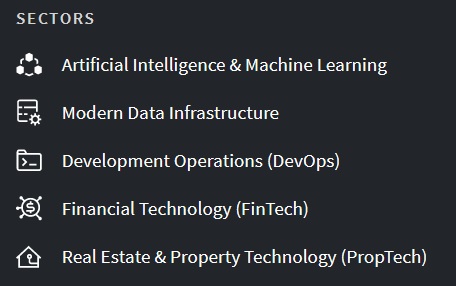Venture Capital Investing for Retail Investors
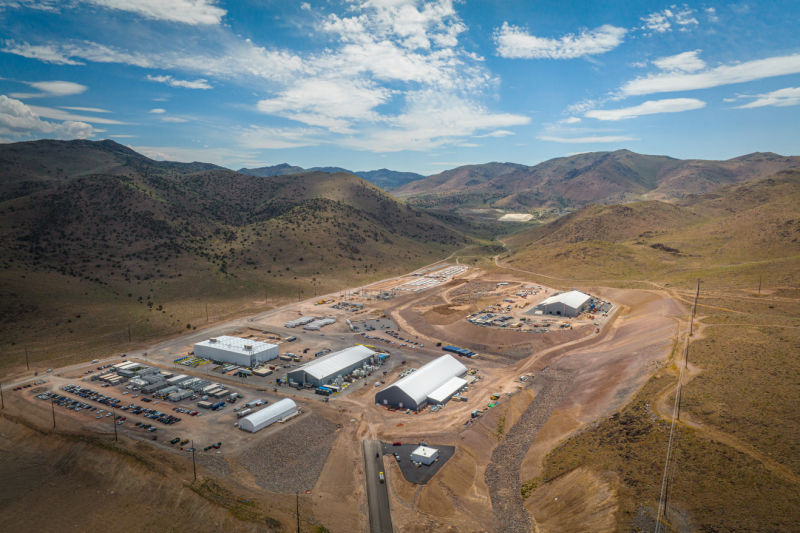
Redwood Materials is a sustainable materials company laying the groundwork for electric vehicle (EV) battery recycling in the U.S. As EVs increase in numbers over the next few decades, many electric cars will reach their end-of-life.
When they do, the raw materials contained within the batteries will retain much of their value.
High-demand metals (e.g., cobalt, lithium, nickel) used in EV batteries are mined worldwide and have complicated supply chains, making them challenging and expensive to acquire to meet car production demand.
Domestic recycling will eventually provide an alternate source of raw materials for manufacturing homegrown batteries while reducing reliance on global supply chains.
Founder J.B. Straubel was the fifth employee at Tesla. He left in 2017 to take on the extraordinary task of forming a new industry.
Recycling hundreds of thousands of car batteries will require significant technological know-how, large industrial facilities, and domestic supply chains to acquire cars and break down their components into usable raw materials.
Building capacity to meet the anticipated demand will take years and billions of dollars before becoming a viable business model, let alone profitable.
Since most EVs ever sold are still on the road, EV battery recycling is in its infancy.
The company has received a $2 billion loan from the Department of Energy. But that’s not enough.
Traditional banks are restricted from making risky and unpredictable loans.
The rest of the money will come from venture capital investors willing to take on long-term risks to potentially earn excellent returns years from now.
Last month, Redwood Materials closed a fresh funding round, raising more than $1 billion.
Redwood Materials is not a publicly traded company yet. There is no Redwood Materials stock, and it probably won’t be for years. But its potential as a viable business is promising enough to entice prominent venture capitalists to contribute hundreds of millions of dollars.
Retail investors are unable to invest.
Table of Contents
What is Venture Capital?
Venture capital is a form of private equity investing where investors place long-term bets on risky opportunities with the potential for high returns.
It plays a vital role in the U.S. economy, financing entrepreneurs, startups, and burgeoning industries. Young companies building ambitious products must hire talented employees before they have any revenue.
Venture capital investments into early-stage companies fuel growth when other funding sources aren’t available.
In return, venture capital investors receive an equity stake in the company receiving funds. Smart investments in the right companies led by extraordinary founders can become fortunes.
Google, Facebook, Amazon, and most public tech companies all accepted venture capital investments during the early growth stages.
Who Invests in Venture Capital?
Venture capital is typically reserved for wealthy individuals and institutional entities such as university endowments, state pension funds, and foundations.
VC firms create funds with specific investment objectives, such as investing in fintech, crypto, or climate-related ventures. Then, they self-fund, raise institutional money through their networks, and invest on their clients’ behalf.
Investing in traditional venture capital requires patience, a high risk tolerance, and significant capital (millions, not thousands). It can take five to ten years to recoup an investment.
Investments in non-public businesses come with significant risk, requiring a degree of sophistication to determine if a startup is worthy of an investment.
Luck and network can play a role. Several well-connected celebrities and sports stars have boosted their wealth through venture capital investments.
Most investments will not work out, so venture capitalists own multiple startups in each fund with the expectation some will fail or fall flat, but the gains from the top-performing investments will provide outstanding returns, carrying the portfolio.
Venture capital is a top-performing asset compared to other common investments.
Over the years, retail investors have been largely left out of venture capital investing. But that has started to change.
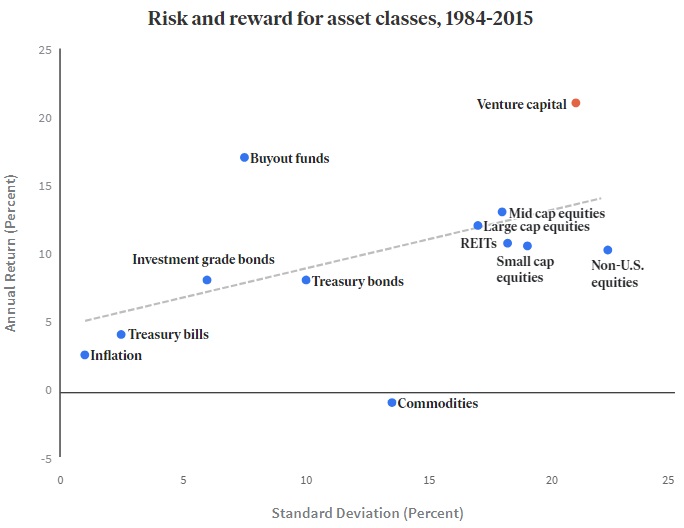
Retail Access to Venture Capital Investments
Startups are staying private longer than they used to. Much of the early growth gains go to the venture capitalists before the IPO instead of retail investors.
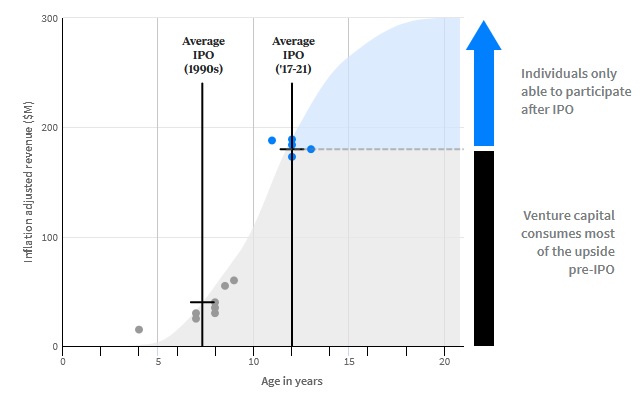
Thankfully, loosened regulations dating back to 2012 have opened up more opportunities for retail access to venture capital.
Below, I’ll discuss three ways retail investors can access venture capital investments in 2023 and beyond.
- Pre-IPO Marketplaces — Purpose: To own individual established mid-to-late-stage pre-IPO companies. Sophisticated accredited investors only.
- Venture Capital Funds — Purpose: To own a professionally managed diversified pool of early-to-late-stage pre-IPO companies. Non-accredited investors are welcome.
- Equity Crowdfunding — Purpose: To own individual early-stage startups with a high likelihood of failure. Non-accredited investors are welcome, but it involves high risk.
Keep in mind VC is not an asset class for everyone. It’s riskier than owning individual stocks.
Retirees looking for income-producing assets should not invest. These investments do not generate income and are illiquid (you can only sometimes sell your stake).
Investors with a 10+ year investment horizon, no immediate need for excess cash, and a high risk tolerance for alternative assets might find the asset class suitable for their investment objects.
VC can increase the risk-reward profile of your total invested portfolio if you proceed with patience and a long-term investment horizon.
Pre-IPO Marketplaces
When companies stay private longer, early employees entitled to equity have limited chances to cash out of their stock options. They can be worth millions on paper but can’t access the wealth.
A few pre-IPO marketplaces have evolved to address this problem. These platforms allow private share owners to cash out, selling their equity stakes to accredited investors.
Big names in the arena include Equitybee, Equityzen, Forge Global, and Linqto.
Equitybee provides accredited investors access to pre-IPO startups by funding employee stock options. In exchange, investors gain a portion of the future stock value.
Other platforms sell direct equity shares not necessarily tied to options. They also offer venture capital funds (10 or more holdings) to accredited investors.
Investing in individual pre-IPO companies is riskier than owning individual stocks because the financials are not up to public company standards. The SEC scrutinizes the financials of public companies via quarterly filings. Pre-IPO companies are not required to file comprehensive public financials until they file for an IPO.
Therefore, pre-IPO investing in individual companies requires some sophistication and professional networks most of us don’t possess.
That said, wealthy individuals who want to increase their portfolio’s risk-return profile can speculate by directly owning these companies. They can reduce their risk if they possess a certain industry knowledge or inside information that could give them an advantage in specific industries. Diversification also helps, but the investment minimums are often high ($10,000+).
For example, a materials science expert who understands the technology and potential of Redwood Materials might consider a direct investment.
The downside risk is real. Venture-backed startups WeWork and FTX were both valued above $30 billion at one point. Where are they now?
There are risks and access restrictions.
But a new investment option emerged in 2022 to give non-accredited investors access to managed, diversified pools of venture-backed startups.
Now, retail investors can benefit from the asset class over the long term and maintain a reasonable risk profile by owning small pieces of multiple startups through funds.
Venture Capital Funds for Non-Accredited Investors
Two unprecedented new investment options emerged in 2022, allowing non-accredited investors to own diversified pools of pre-IPO startups in one fund.
The fund managers found a way to offer the funds to non-accredited investors by qualifying the investments with the SEC, in a process similar to how real estate crowdfunding platforms crowdfund to buy investment properties.
These are managed funds and, therefore, require substantial management fees — 1.85% to 2.90%. That’s the price of accessing this alternative asset class. But investment minimums are low, as little as $10. Past performance results are unavailable, so we’re betting the returns net of fees will outperform stocks.
Please note: If you are interested in these types of funds after reading this post, I encourage you to read the comprehensive reviews linked at the end of each section. I go into much more detail in the reviews than I can here (this post is already too long).
The Fundrise Innovation Fund
The first company to announce this kind of fund was one familiar to many of us: Fundrise. Fundrise is a leader in the real estate crowdfunding space, leveraging its existing investment platform, SEC filing expertise, and experience as a technology startup to manage a new venture capital fund.
Fundrise launched the Fundrise Innovation Fund in July 2022.
The Fundrise Innovation Fund is a new alternative asset fund giving non-accredited investors access to private companies.
As of this article, the Fund holds five pre-IPO startups, including Vanta and ServiceTitan. More venture investments are in the pipeline.
Those companies might not be household names, but they are likely future public companies or acquisition candidates. And investors can own a piece of them now during their growth phases, potentially years before their IPOs.
Here are the Fund’s focus sectors:
I’ve invested in Fundrise real estate funds since 2017, so I was excited about the Innovation Fund, especially because it jives with my IPO investing background and website*.
I invested in the Fundrise Innovation Fund the first chance I got in late December 2022 when it opened to existing platform investors.
The Fund was closed to non-Fundrise real estate investors for a year after its launch. But new investors are now welcome to open an account and invest.
I maintain a comprehensive Fundrise Innovation Fund Review on my other website* that gives all the details about the fund, including current holdings (updated regularly), fees, and everything else you need to know.
The total annual fee of the invested amount is 1.85%. The minimum to invest is $10.
It will not be a pure pre-IPO fund as it holds some public corporate debt and plans to own some public stocks to help maintain some internal liquidity.
This is a long-term growth opportunity that is illiquid and not suitable for passive income. I’m investing to further diversify my invested assets and increase my portfolio’s risk-reward profile.
It’s a young investment fund without a proven track record. But past performance is not indicative of future results anyway, right?
Please note: This is a testimonial in partnership with Fundrise. We earn a commission from partner links on RetireBeforeDad.com. All opinions are my own.
Fundrise conducted its own Fundrise iPO (“internet public offering”) in 2017. We recently learned it’s happening again. This looks like it will be separate from the Innovation Fund.
The ARK Venture Fund via SoFi Invest
A few months after the Fundrise announcement, Cathie Wood, a well-known investment manager, launched the ARK Venture Fund. It is available at SoFi Invest.
Cathie Wood is famous for her appearances on CNBC and multiple tech-focused ETFs. She made a big bet on Tesla during its incredible growth years, delivering outperformance to her clients.
The ARK Venture Fund aims to own both pre-IPO startups and public tech stocks to benefit from high-growth industries such as artificial intelligence.
It launched with fanfare and started onboarding new investors immediately.
Some of the pre-IPO holdings include X Corp (formerly Twitter), Zipline (drone delivery), Anthropic (AI), and Axiom Space. Public holdings include Tesla, NVIDIA, Coinbase, Zoom, CRISPR, and Shopify.
I maintain a comprehensive ARK Venture Fund review on my other website* that gives all the details about the fund, including current holdings (updated regularly), fees, and everything you need to know. The total annual fee is 2.90% of the invested amount. The investment minimum is $500.
The ARK Venture Fund is also an illiquid long-term growth opportunity and unsuitable for passive income. But I’m investing in this fund as well.
Equity Crowdfunding
Not to be confused with mid-to-late-stage pre-IPO investing discussed in the previous two items, equity crowdfunding is another form of venture capital with a higher degree of risk.
Nonetheless, the same regulations that loosened rules for real estate crowdfunding investing in 2012 enabled equity crowdfunding opportunities for non-accredited investors.
About 15-20 years ago, crowdfunding gained popularity via websites like Kickstarter and Indiegogo. These platforms empowered founders to raise money for a product with only an idea.
“Investors” could “invest” in an idea, such as a fancy cooler or virtual reality headset (Oculus Rift started this way). In return, investors would receive the product when it was ready to ship.
They could not invest to receive equity.
The JOBS Act of 2012 changed that, allowing investors to buy into seed-stage startups.
Equity crowdfunding is now a way for businesses to raise money from the masses, collecting smaller investment amounts from hundreds of different investors.
Popular platforms such as WeFunder and StartEngine (now plastered with Kevin O’Leary’s endorsement) facilitate this form of investing.
Equity crowdfunding is even riskier than mid-to-late-stage pre-IPO investing because many of the companies featured are in the very early stages of business.
It often involves investing “seed money” into brand-new companies. If the companies succeed, deeper-pocketed venture capital funds will eventually follow suit.
Some more mature companies raise funds, too. Two real estate investing platforms I’ve featured on this website have run campaigns on WeFunder in the past year (more below).
But I’ve mostly observed equity crowdfunding to be earlier-stage, unproven companies.
A few equity crowdfunding success stories include:
- Boxabl — Pre-fabricated homes delivered on a truck.
- Miso Robotics — Fast food robots that can cook French fries and make coffee.
- Knightscope — Robot rent-a-cops.
But most investors should stay away unless you have specific industry or personal knowledge of a company or employees running a crowdfunding campaign.
The lower-risk opportunities are in early-to-mid-stage startups with established business models (like EquityMultiple and Arrived).
Higher-risk, higher-return opportunities exist where founders have an idea upon which they want to build a business. But you’re investing in the idea and the founder(s), both of which could fail.
Equity crowdfunding is not an appropriate asset for most investors. That said, I’m currently testing the waters with my first WeFunder investment this year.
How I’m Investing in Venture Capital
Now that I’ve run through the various ways individual investors can invest in venture capital, I’ll share how I’m invested today and plan to invest going forward.
My Two Venture Capital Funds
Since these are higher-risk opportunities, I’m starting with relatively small amounts and planning to grow my holdings over time. Ideally, I’ll create a recurring deposit and dollar cost average into these funds.
That said, I’m not investing much new capital these days because of reduced cash flow due to my switch to self-employment.
I think little about the returns on these holdings because I expect to be invested for at least a decade. But here they are:
| Fundrise Innovation Fund | ARK Venture Fund | |
| Initial Investment Date | 12/28/2022 | 10/07/2022 |
| Total Invested | $3,000.00 | $1,000.00 |
| Value as of Sept 2023 | $2,983.99 | $1,240.73 |
None of the companies in either fund have had an IPO yet. But the ARK Venture Fund had one exit.
A company called MosaicML was acquired by Databricks (a big private company) for 6X what the fund paid for the holding less than a year before.
MosaicML was 2.5% of the ARK Venture Fund portfolio at the time. The price impact isn’t clear yet, but we’ll find out in the coming months. It certainly helps!
Before these funds, it was much more difficult to benefit from that kind of private transaction. Large gains will offset bets that don’t pan out.
And that’s the nature of venture capital investing. Big wins from a small subset of a broader portfolio carry the funds and offset more frequent duds.
Over the next decade, I expect these two funds to remain leaders in the space. I have a longer track record with Fundrise and am confident in their CEO, Ben Miller, who is spearheading the fund.
Cathie Wood is also exceptionally experienced, but the ARK Venture Fund holds many public companies to maintain fund liquidity. I prefer more private companies and less liquidity. We’ll see if Fundrise follows this model.
We may also see more venture capital funds targeting non-accredited investors soon. Pre-IPO platform Linqto alluded to joining the fray in a recent email.
Venture capital investing is speculative — no doubt about it. As such, my investments will only ever make up no more than 1-2% of my net worth.
My First Equity Crowdfunding Investment
Over the years, I’ve enjoyed experimenting with innovative investments in search of diversified returns. I’ve found them in real estate crowdfunding, IPO investing, and peer-to-peer lending, among others.
Equity crowdfunding has been around for more than a decade. But in 2023, I’ve taken my first step at owning an early-stage startup.
The company is one where I’m a customer, enjoy the user experience, and believe there is a long-term growth opportunity.
It’s Arrived Homes, where individual investors can own pieces of rental homes and vacation rentals.
I’ve reviewed the Arrived Homes investing platform, and I’m sharing my returns online. Now, I’m in line to become an owner alongside Jeff Bezos, Marc Benioff (Salesforce), and Dara Khosrowshahi (Uber).
Arrived is conducting a crowdfunding campaign on WeFunder to raise $1 million at a $100 million valuation. Here’s the campaign.
There is so much interest that they had to cap the maximum investment per investor at $500.
Equity crowdfunding laws are imperfect, so there are legal limitations on how much companies can raise this way. Hence, the cap.
That means only 2,000 investors can participate in the private round; collectively, we’ll own 1%. I’ll own somewhere around 1/2000th of 1%.
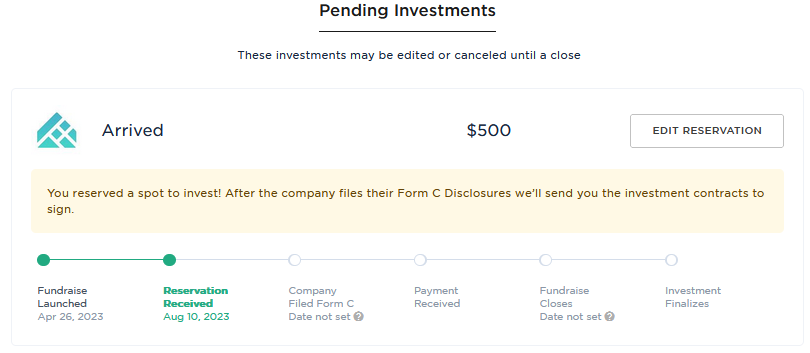
Boo, only $500. Oh well.
The deal is still working its way through the process. I hope it’s an interesting endeavor that I can share more with you over time.
I have no further plans to invest in equity crowdfunding. But I could be tempted again.
My preference is the more diversified later-stage venture capital funds, where I can own small pieces of the next generation of public companies.
Redwood Materials isn’t in either of the VC funds I highlighted above. But maybe someday.
* I run another website called AccessIPOs.com. Since IPO investing is significantly more specialized and risky than traditional investing and personal finance, I spun the site off of RBD in 2016 and try to keep things separate. In this case, venture capital may interest many RBD readers as a long-term buy-and-hold alternative investment. In contrast, IPO investing is more of an active investing/trading activity not interesting for most RBD readers.
Featured photo courtesy of Redwood Materials

Craig is a former IT professional who left his 19-year career to be a full-time finance writer. A DIY investor since 1995, he started Retire Before Dad in 2013 as a creative outlet to share his investment portfolios. Craig studied Finance at Michigan State University and lives in Northern Virginia with his wife and three children. Read more.
Favorite tools and investment services right now:
Sure Dividend — A reliable stock newsletter for DIY retirement investors. (review)
Fundrise — Simple real estate and venture capital investing for as little as $10. (review)
NewRetirement — Spreadsheets are insufficient. Get serious about planning for retirement. (review)
M1 Finance — A top online broker for long-term investors and dividend reinvestment. (review)

